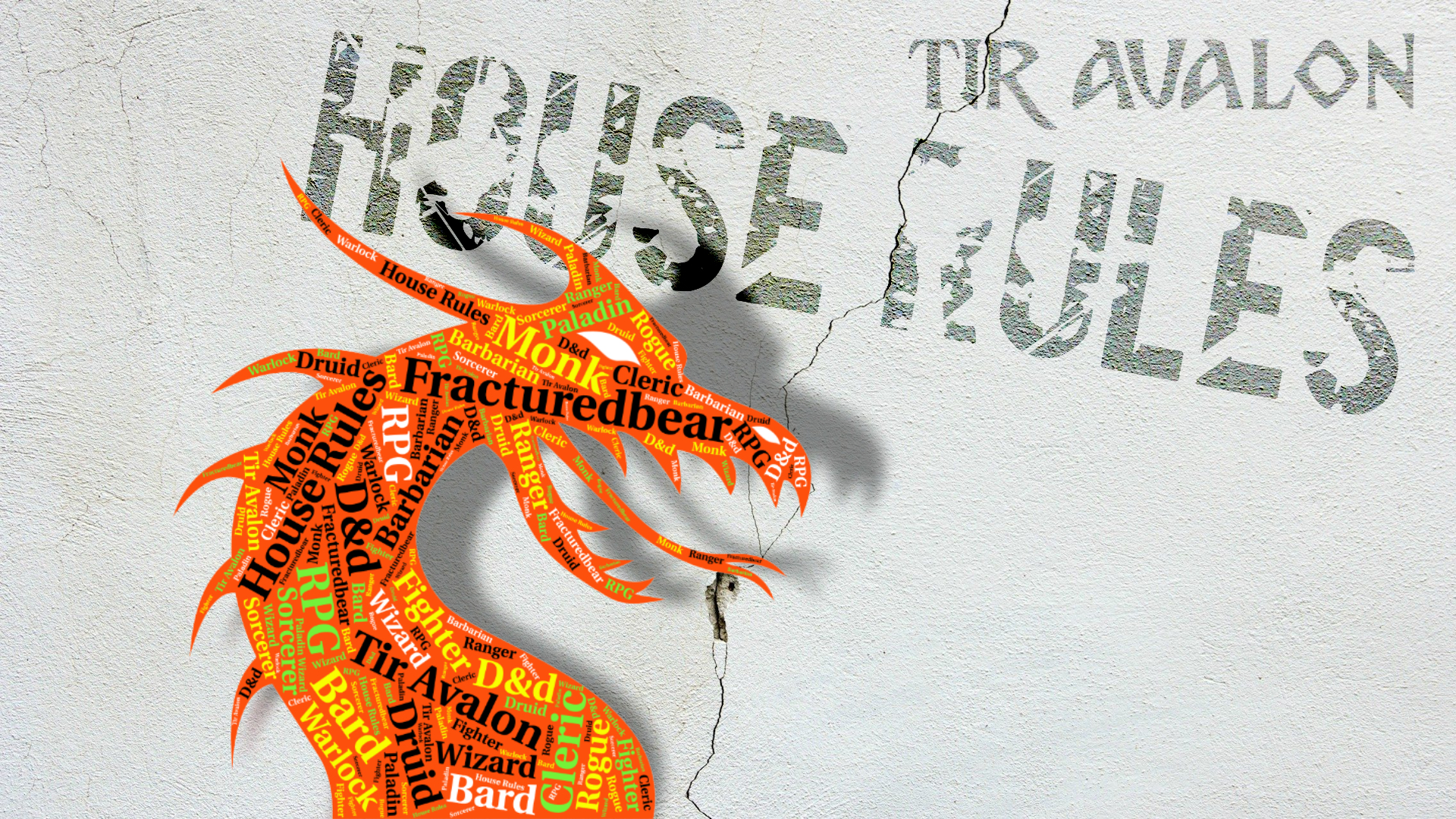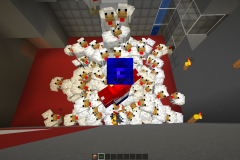This is where I keep information on the modifications I have made to the base game of 5th Ed D&D to play in my home campaign world of Tir Avalon. This is also a place to find all the recorded answers to questions for playing in D&D 5e, in Tir Avalon. Tir Avalon is a living changing world.
The rules for Tir Avalon come from all versions of the game, and are a manifestation of all the things I wanted to include in a world, and to help drive the narrative I have gone back as far as the 70s when Blackmoor Supplement II came out. Also, I find the 5e system good, it’s TOO dumbed down to play like a dice controlled MMO. So these rules are aimed at bringing back some of the older versions of the game, applying some logic (my form of it anyway) and then making it work as a narrative for the story.
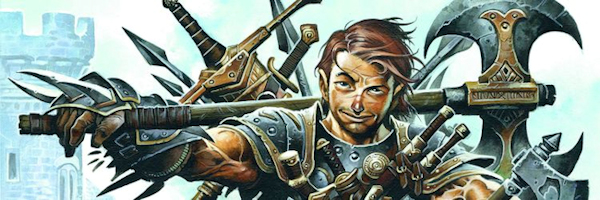
In Tir Avalon, characters and NPCs don’t learn EVERY weapon. No one that does not dedicate everything to it could, and considering the wide range of skills, it seems unlikely that a fighter, would be able to master every type of ranged weapon, mounted weapons, footmen (polearms) as well as the use of a shield, and close quarter combat.
Weapon Proficiencies
So in Tir Avalon, the following restrictions apply to selection of weapons.
- Barbarian: Any three weapons from any list. Plus one cultural weapon, depending where the barbarian’s background has them coming from.
- Bard: Any two weapons from the simple weapons list, Hand Crossbows, Longswords, Rapiers, Shortswords. Some bardic colleges do teach weapons training, and they provide an additional weapon.
- Cleric: Any three from simple weapons. Some faiths also have specific requirements for their faith to wield specific weapons, clerics of that faith are also trained in that weapon, and are expected to use it as their primary as per their faith’s doctrines.
- Druid: Any two from Clubs, Daggers, Darts, Javelins, Maces, Quarterstaves, Scimitars, Slings. Spears. Sickles are also learned. Some lands have specific weapon equivalents: in the lands of Min Misr the scimitar is replaced with the Khopesh, and a druid from there would learn it instead of the Scimitar if they so wished.
- Fighter: Any four weapons. See Specilisation below.
- Monk: Any three weapons from the simple list, or Shortsword.
- Paladin: Any three weapons. Some faiths also have specific requirements for their faith to wield specific weapons, paladins of that faith are also trained in that weapon, and are expected to use it as their primary as per their faith’s doctrines.
- Ranger: Any two melee weapons and one ranged weapon. Some rangers are restricted depending upon their background to specific weapons they are trained and identified as using, as well as regional options and changes too (see druid above).
- Rogue: Any three weapons from Simple Weapons, Hand Crossbows, Longswords, Rapiers and Shortswords.
- Sorcerer Any two from Daggers, darts, slings, Quarterstaves, Light Crossbows.
- Warlock Any two from Simple Weapons.
- Wizard Any two from Daggers, darts, slings, Quarterstaves, Light Crossbows.
Specialisation
At any time a character gets an option to increase their stats, or take a feat, they may instead specialise in a weapon with which they are proficient. This gives the character a +1 to hit with that weapon as well as a +2 to damage.
Weapon Modifications
The following Weapons are modified:
- Longswords when wielded with two hands, only adds 1 point to the damage.
- Scimitars do 1d8 slashing damage, not 1d6.
New / Extra Weapons.
Bastard Sword 
This sword is similar to a long sword in size and weight, but has a longer hilt. It can be used one- or two-handed.
Cost: 25GP • Damage: 1H=1d8, 2H = 2d4 • Weight: 10lbs
 Broadsword
Broadsword
Cost: 15GP • Damage: 2d4 • Weight: 4lbs
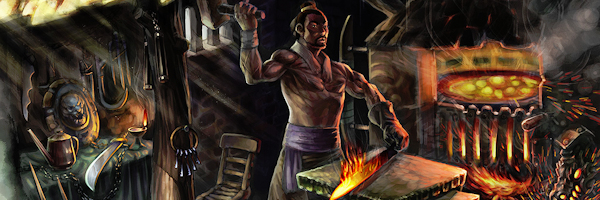
The following feats are allowed in Tir Avalon, some are copied from various sources online, and some of my own, as well as a few from online I modified to suit Tir Avalon.
Select the letter below to see what Feats are available. Any letters missing is because I don’t have a feat starting with that letter. If you have a suggestion, leave a comment below.
[advanced_iframe src=”http://fracturedbear.com/Feats/feats.php” width=”100%” height=”1200″]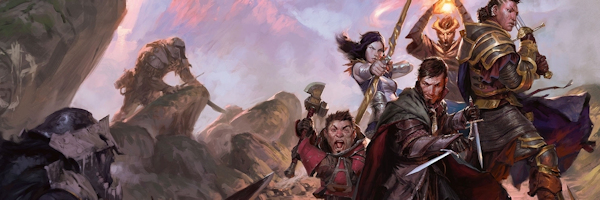
Class Modifications
Some classes are changed to suit the game world of Tir Avalon, as a result, the following changes are confirmed, while others are being thought about.
Bard: Bards must declare for a college, or tutored privately (only a chance of this, depends on where the character comes from (especially the background the player has chosen), and as a result from these will determine access to a private tutor.
Clerics: Clerics when choosing where they come from will be given options for whom can be worshiped openly, or hidden, and which gods have influence there. Clerics from foreign lands have limited access to powers (limit of 4th level spells when not in a region of influence of their deity).
Fighter: Fighters can take the Archery Fighting Style; however it is limited to Light and Heavy Crossbows. Archery is now mainly for the Rangers.
Rangers:
Rangers now have a new Archetype (still being completed but can be ready if required) more inline with fictional and old school rangers. Core rangers come from one region of Tir Avalon only, so it is with special note you should select this class carefully as it DOES lock you into some things. The Archetype is called a “Crown’s Ranger”, and if you have read the Apprentice series of books you will know exactly what I am talking about.
Second Ranger update is to the Beastmaster Archetype. If the player is choosing this path, then the following happens:
- Beastmasters do not sacrifice an attack to command a companion, the example in the PHB cites telling it where to go, and then to attack (using your action). This is ludicrous. Trained animals are trained with commands to allow for that kind of specific targeting, look at sheep dog trials one day. So it is assumed that you have a system worked out, through your bonding with the animal, or a shortcut to instructions to allow you to tell the dog to attack or whatever command succinctly.
- Animal companions are slightly more intelligent than normal relatives of theirs. As a result stats are rolled for the companion and compared to the original entry. Any stat higher, adds half the difference to the base stat. For example a STR10 animal rolls a STR14. The difference is 4, half that is 2, so the orginal stat of 10 has a +2 added to it for a new total of 12. Animals of high intelligence can be taught tricks (see below).
- They gain their first companion at 1st level, but they gain no benefits from the ranger, or vice versa and the companion is NOT under the control of the player and will be directed by the GM.
- At second level the companion gains a +1 bonus as per the PHB (Page 99) and is under the control of the player in non combat situations, where the GM takes over.
- At third level the Ranger now has the same control as per the PHB, now they have built trust and a raport with the companion.
- At 5th level, the ranger can have up to 3 companions, whose total CR is less than 1/4CR.
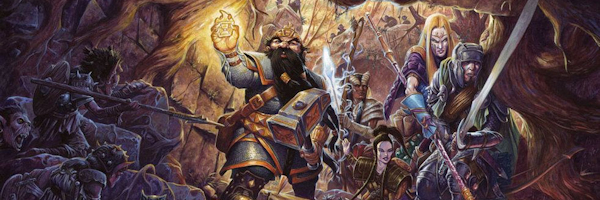
Called Shots
I use a called shots system. If you want to hit a specific target, ie the eye of a creature, then the following happens.
Target modifiers are based upon the size of the target, and the part you want to hit. hitting a leg is easier than hitting an eye for example. So with that in mind, here is the basic premise.
- To hit a limb on a creature, is a -4 attack roll if the creature is the same size as the player. This is reduced by one for every two size categories the creature increases in size, and the opposite if it is smaller.
- To attack a hand, head, foot for example is a further -2 to the attack roll, with the same modifiers.
- To go for an eye, is a a -8 penalty, again modified by size.
- The speed of the target effect the attack roll when the target is making a dash action (not disengage etc), o if they are just flat out running (double movement) they are slightly harder to hit, so they attract a -1 penalty to attack as well.
- Targets at long range, also gain a -2 penalty on a called shot.
Examples:
- Elf shooting an arrow at a Frost Giant’s eye. The start of the attack gains a -8 to hit, however the size reduces that down to -7.
- Human Ranger shooting at an imp to wing it (literally). Wings count as limbs, so a tiny creature’s wing would calculate as -4 to hit, as well as another -1 for the size, making it a total -5 modifier to attack.
- Dwarf crossbowman shoots his bolt to hit the knee of a running Hill Giant in the distance to drop him, modifiers calculate as: -4 for called shot, Huge creature reduces the penalty by 1 to -3. Going for the knee makes it -5 to attack, the target is also moving fast, so the attack is now at -6, and it’s also long range, giving a final -8 penalty to hit a running Hill Giant in the distance, and unless they have Sharpshooter or some class action to remove the penalty, the long range shot is at disadvantage as well.

Resting & Hit Dice
- SHORT rests only allow you to roll ONE (1) HD to recover HPs.
- LONG rests allow you to roll HD equal to your CON Modifier, with a minimum of one (1).
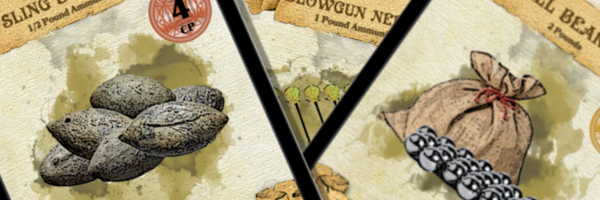
Adventuring Gear
Gear on the following page is available, with the exceptions of anything listed in this post, and the following exceptions (after the link). Also items from other sources can be added to the list, and many are from the following (if you can get access):
- Aurora’s Whole Realms Catalogue ( I am currently slowly working on them, and you can find them in (Cosmo’s Emporium)
- D&D 3/3.5 Arms and Equipment Guide
Exceptions List (incl ammunition also)
- ANYTHING specific to a class listed on the D&D Wiki page or linked from it.
- Mechanic’s Pack
- Land Mine
- Miner’s Mate
- Parachute
- Personal Glider
- Saddle of Haste
- Smoldering Paste
- Alchemical Reagant Set
- ANYTHING in the following sections:
- Renaissance
- Modern
- Futuristic
- Clockwork Items
Armour & Shields
Shields

A buckler (or target shield) is a very small shield that fastens on the forearm. It can be worn by crossbowmen and archers with no hindrance. Its small size enables it to protect against only one attack per turn (of the user’s choice), improving the character’s Armor Class by 1 against that attack.

A small shield is carried on the forearm and gripped with the hand. Its light weight permits the user to carry other items in that hand (although he cannot use weapons). It can be used to protect against two frontal attacks of the user’s choice.
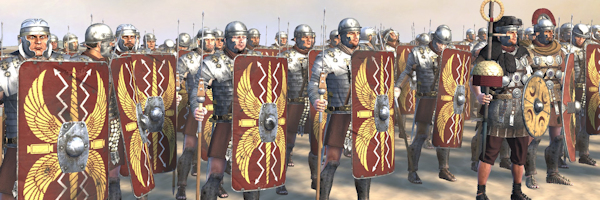
The medium shield is carried in the same manner as the small shield. Its weight prevents the character from using his shield hand for other purposes. With a medium shield, a character can protect against any frontal or flank attacks.
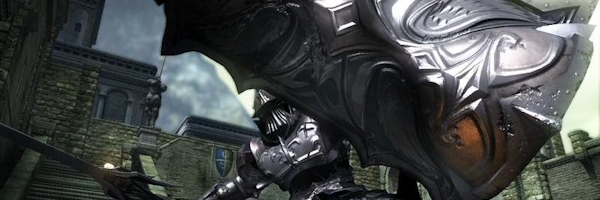
The body shield is a massive shield reaching nearly from chin to toe. It must be firmly fastened to the forearm and the shield hand must grip it at all times. It provides a great deal of protection, improving the Armor Class of the character by 1 against melee attacks and by 2 against missile attacks, for attacks from the front or front flank sides. It is very heavy; the DM may wish to use the optional encumbrance system if he allows this shield.
Armor
There are only a couple of changes to the armor.
- Plate is now basically Field Plate. Nothing has changed other than the name.
- Full Plate is added to the list. Details as follows:
- Cost: 2500GP
- AC: 19
- Strength: 16
- Stealth: Disadvantage
- Weight: 75lbs
- Details: This is the impressive, high Gothic-style armor of the Late Middle Ages and Renaissance. It is perfectly forged and fitted. All the plates are interlocking and carefully angled to deflect blows. The surfaces are normally highly ornamented with etching and inlaid metals. Each suit must be carefully custom-fitted to the owner and there is only a 20% chance that a captured suit can be refitted to a new owner of approximately the same size. The metal plates are backed by padding and chain mail. The weight is well-distributed. The armor is hot, slow to don, and extremely expensive. Due to these factors, it tends to be used more for parades and triumphs than actual combat.

Special Materials
Tir Avalon makes use of special materials, and crafting. This allows for improvements in equipment, without massive cost, still SOME cost, but not magical enchantment levels. Though this is defendant upon the materials being used.
Adamantine
This ultra hard metal adds to the quality of a weapon or suit of armor. Weapons fashioned from adamantine have a natural ability to bypass hardness when sundering weapons or attacking objects, ignoring hardness less than 20. Armor made from adamantine grants its wearer damage reduction of 1/- if it’s light armor, 2/- if it’s medium armor, and 3/- if it’s heavy armor. Adamantine is so costly that weapons and armor made from it are always of masterwork quality; the masterwork cost is included in the prices given below. Thus, adamantine weapons and ammunition have a +1 enhancement bonus on attack rolls, and the armor check penalty of adamantine armor is lessened by 1 compared to ordinary armor of its type. Items without metal parts cannot be made from adamantine. An arrow could be made of adamantine, but a quarterstaff could not.
Only weapons, armor, and shields normally made of metal can be fashioned from adamantine. Weapons, armor and shields normally made of steel that are made of adamantine have one-third more hit points than normal. Adamantine has 40 hit points per inch of thickness and hardness 20.
Additional Costs:
[sc name=”equipment_panel” ammo=”+60 ea.” weapon=”+3000″ shield=”+2000″ light=”+5000″ medium=”+10000″ heavy=”+15000″]Darkwood
This rare magic wood is as hard as normal wood but very light. Any wooden or mostly wooden item (such as a bow, an arrow, or a spear) made from darkwood is considered a masterwork item and weighs only half as much as a normal wooden item of that type. Items not normally made of wood or only partially of wood (such as a battleaxe or a mace) either cannot be made from darkwood or do not gain any special benefit from being made of darkwood. The armor check penalty of a darkwood shield is lessened by 2 compared to an ordinary shield of its type. To determine the price of a darkwood item, use the original weight but add 10gp per pound to the price of a masterwork version of that item. Darkwood has 10 hit points per inch of thickness and hardness 5.
Iron, Cold
This iron, mined deep underground, known for its effectiveness against fey creatures, is forged at a lower temperature to preserve its delicate properties. Weapons made of cold iron cost twice as much to make as their normal counterparts. Also, any magical enhancements cost an additional 2,000gp.
Items without metal parts cannot be made from cold iron. An arrow could be made of cold iron, but a quarterstaff could not. A double weapon that has only half of it made of cold iron increases its cost by 50%. Cold iron has 30 hit points per inch of thickness and hardness 10.
Mithral
Mithral is a very rare silvery, glistening metal that is lighter than iron but just as hard. When worked like steel, it becomes a wonderful material from which to create armor and is occasionally used for other items as well. Most mithral armors are one category lighter than normal for purposes of movement and other limitations. Heavy armors are treated as medium, and medium armors are treated as light, but light armors are still treated as light. Spell failure chances for armors and shields made from mithral are decreased by 10%, maximum Dexterity bonus is increased by 2, and armor check penalties are lessened by 3 (to a minimum of 0).
An item made from mithral weighs half as much as the same item made from other metals. In the case of weapons, this lighter weight does not change a weapon’s size category or the ease with which it can be wielded (whether it is light, one-handed, or two-handed). Items not primarily of metal are not meaningfully affected by being partially made of mithral. (A longsword can be a mithral weapon, while a scythe cannot be.)
Weapons or armors fashioned from mithral are always masterwork items as well; the masterwork cost is included in the prices given below. Mithral has 30 hit points per inch of thickness and hardness 15.
Costs
[sc name=”equipment_panel” ammo=”+50 ea.” weapon=”+3000″ shield=”+1000″ light=”+1000″ medium=”+4000″ heavy=”+9000″]Silver, Alchemical
A complex process involving metallurgy and alchemy can bond silver to a weapon made of steel so that it bypasses the damage reduction of creatures such as lycanthropes.
On a successful attack with a silvered weapon, the wielder takes a -1 penalty on the damage roll (with the usual minimum of 1 point of damage). The alchemical silvering process can’t be applied to nonmetal items, and it doesn’t work on rare metals such as adamantine, cold iron, and mithral. Alchemical silver has 10 hit points per inch of thickness and hardness 8.
Costs
- Ammunition: +2 gp
- Light weapon: +20 gp
- One-handed weapon, or one head of a double weapon: +90 gp
- Two-handed weapon, or both heads of a double weapon: +180 gp
Baatorian Green Steel
Deep in the mines of the Nine Hells of Baator, veins of green-flecked iron run through the rock. This rare metal, when alloyed into steel, can be used to create weapons of amazing sharpness. Any slashing or piercing weapon created with Baatorian green steel has a natural enhancement bonus of +1 to damage. This bonus does not stack with any other enhancement bonus. Thus, a green steel (+1 to damage) longsword with a +4 enhancement bonus effectively has a +4 enhancement bonus on both attacks and damage. In an area where magic does not function, it still retains its natural +1 enhancement bonus on damage.
A masterwork green steel slashing or piercing weapon would have a +1 bonus on both attack and damage rolls (from a combination of masterwork and the green steel). Though green steel is a common component of keen weapons produced in the Lower Planes, it grants no other special ability to such weapons. The market price modifier
for such a weapon is +2,000 gp. Baatorian green steel has a hardness of 12 and 30 hit points per inch of thickness.
Gehennan Morghuth-Iron
This volcanic mineral is unique to the steep mountains of the Bleak Eternity of Gehenna, where it is occasionally mined by neutral evil fiends called yugoloths and other creatures on that forbidding plane. It forges poorly, making weapons that appear pocked and pitted and have a –1 attack and damage penalty. However, morghuth-iron is extremely toxic, rapidly poisoning the blood. A slashing or piercing weapon made of Gehennan morghuth-iron is naturally poisonous. The weapon delivers its poison (Fortitude save DC 12) with each successful attack. The initial damage is 1 point of temporary Dexterity; the secondary damage is 1d4 points of temporary Dexterity.
The market price modifier for a weapon made of morghuth-iron is +4,000 gp. Gehennan morghuthiron has a hardness of 9 and 20 hit points per inch of thickness.
Solanian Truesteel
Mined on the fourth layer of the Seven Mounting Heavens of Celestia, this fine iron needs no alloy and shines with a silvery gleam. When forged into a weapon, it gives the wielder a +1 bonus on the confirmation roll for a critical hit. The market price modifier for such a weapon is +1,000 gp. Solanian truesteel has a hardness of 11 and 25 hit points per inch of thickness.
Hyperion Steel
Hyperion steel is an alloy from a secret recipe, when crafted the steel is very difficult to sharpen, but retains it’s edge once done, and once finally forged and tempered, the Hyperion steel is impervious to rust and decay, and cannot be dulled. This is particularly prized amongst those that encounter or deal with Rust Monsters.
Cost modifier for a Hyperion blade is +1000gp. It has a hardness of 11 and 30 hit points per inch of thickness.
Umbrite
Umbrite is a dark, dense green metal of surprising hardness. While Umbrite is no match for the hardness of mithral or adamantine, it is stronger than steel and easily among the most durable metals known. Beyond its capable performance as a metal, Umbrite is remarkable for its light-absorbing qualities. Umbrite seemingly absorbs light at a slow rate, causing shadows around it to deepen considerably.
Umbrite forged items are immensely expensive. A forged Umbrite item weighing 1 pound or more retains much of its light-absorbing properties. While wielding any Umbrite item of 1 pound or more, the user gains a +3 circumstance bonus to all Hide checks. Shadows around him seem to be deeper and darker. This affects a 5-foot area around the wielder and does not extend to others. However it must be unsheathed for the effect to work if a weapon, or some unexposed armor.
Cost is 300x the base value of the item. Hardness is 12, with 18 hp per inch of steel.
Craftsmanship
The quality of a weapon in the base game is that of a well forged but average quality. There are masters who can craft … well better than that. These rules apply for the crafting of weapons or armor as appropriate.
Masterwork
The masterwork needs to be crafted by a mid level or higher guild craftsman, or master armorer. It takes three times as long to finish the item, and five times the original cost, but it gives it a keener edge, granting a natural +1 bonus to attack, that does not stack with magical bonus.
When a masterwork suit of armor (metal only, not studded leather) it gains the following:
- DEX bonus limitations are raised by one for heavy suits of armor granting a +3 to AC if the DEX is high enough.
- Donning and Doffing the armor now takes 2 rounds less to complete.
Exceptional Masterwork
Exceptional Masterwork items have all the same benefits of a Masterwork item, with the following. The time for completion is 10 times the base, and 100 times the cost.
- Weapons gain +1 to damage, that DOES stack with magical bonus (it’s just THAT damnably sharp now).
- Armor now allows for a further +1 max DEX bonus, to +4.

The following is a breakdown of races available in Tir Avalon.
Races from any WotC 5e source books from Wizards, things like Genasi. The exception being the Deep Gnomes (Smirfneblin), as they come under the Gnomes comments below. There are other races in the D&D Wiki Homebrew and designed by companies OTHER than WotC for 5E. SOME of them may be okay, if you want to use one, please let me know what it is, where are the details, and why the race is required or wanted for the build.
Races allowed with modification
If a race, or racial variant, is NOT shown on this list it is not allowed, or needs review.
- Dwarf
- Elf (High, Wood or Drow)
- Halfling
- Human ( or the Variant)
- Dragonborn (Metallic, Chromatic or Faerie Dragonborn)
- Half-Elf
- Half-Orc
- Tiefling
- Aasimar (Protector, Scourge or Fallen)
- Firbolg
- Goliath
- Kenku
- Lizardfolk
- Tabaxi
- Triton
- Orc
- Yuan-Ti Pureblood
- Minotaur (see below)
Minotaur
The Minotaur in Tir Avalon is based on the UA one that’s been out for some time, it has a few slight modifications, but over all it’s the same as the original.
The Minotaurs in Tir Avalon have created a Roman like society, and have NOT been affected by Baphomet, and are free. The nation is called the The Taursinian Empire.
Minotaur Traits
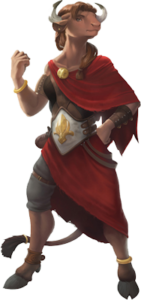 The following traits are shared by player characters who are minotaurs. Ability Score Increase. Your Strength score increases by 2, and your Constitution score increases by 1.
The following traits are shared by player characters who are minotaurs. Ability Score Increase. Your Strength score increases by 2, and your Constitution score increases by 1.
- Alignment. Most minotaurs lean toward lawful alignments.
- Size. Minotaurs average over 6 feet in height, and they have strong, stocky builds. Your size is Medium.
- Speed. Your base walking speed is 30 feet.
- Horns. Your horns are natural melee weapons, with which you’re proficient. When you hit with them, the target takes piercing damage equal to 1d6 + your Strength modifier.
- Goring Rush. Immediately after you use the Dash action on your turn and move at least as far as your speed, you can make one melee attack with your horns as a bonus action.
- Hammering Horns. Immediately after you hit a creature with a melee attack as part of the Attack action on your turn, you can attempt to shove that creature with your horns using your reaction. The creature must be no more than one size larger than you and within 5 feet of you. It must make a Strength saving throw against a DC equal to 8 + your proficiency bonus + your Strength modifier. If it fails, you push it up to 5 feet away from you.
- Menacing. You have proficiency in the Intimidation skill.
- Hybrid Nature. You have two creature types: humanoid and monstrosity. You can be affected by a game effect if it works on either of your creature types.
- Languages. You can speak, read, and write Common and Taursinian.
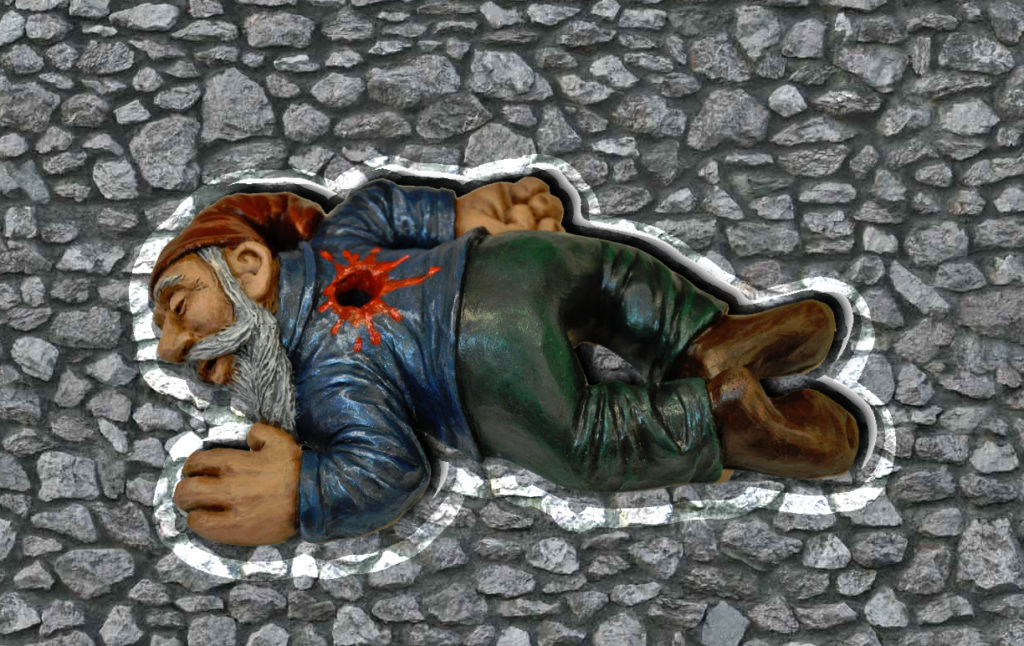
Gnomes:
Or Ouphen as they are called in Tir Avalon, as far as the ones from the PHB and main D&D gaming materials are concerned, are NOT native to the Tir Avalon world, and while there are scattered pockets of them, they are only available once to any player ONCE only. They also can not be your first or second character in Tir Avalon.
There are native Gnomes to the world, however they are small elemental fey and not character races.

